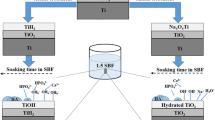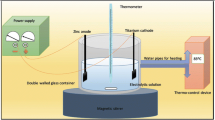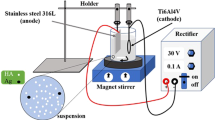Abstract
Bioceramic hydroxyapatite/sodium titanate coating on sandblasted titanium substrate was fabricated by a three-step process. At first, the sandblasted titanium substrate was coated with a flake-like sodium titanate layer by alkali-heat treatment. In the second step, the alkali-heat treated titanium substrate was hydrothermal treated at 180 °C for 4 h with calcium solutions. In the third step, the hydroxyapatite (HA) coating was deposited onto the hydrothermal treated layer via electrochemical deposition method. The surface topography and roughness of the coatings were determined by field emission scanning electron microscope (FESEM) and a mechanical contact profilometer, respectively. The surface compositions were evaluated by X-ray diffraction (XRD), energy-dispersive X-ray spectrum (EDS), and X-ray photoelectron spectroscopy (XPS). The EDS, XPS, and XRD analysis confirm the presence of element Ca, Ca2+, and CaTiO3 on sodium titanate layer after hydrothermal treatment with Ca(NO3)2 solution, respectively. FESEM micrograph shows the rod/needle-shaped crystallites are highly densely packed on the calcium-ion-containing layer with an average size of ~50 nm in diameter. The results indicate that the sodium titanate layer containing Ca2+ ions possesses higher ability to induce HA formation compared with the pure sodium titanate layer. It is revealed that surface composition plays an important role in the electrochemical deposition of HA. The calcium-ion-containing layer probably makes the nucleation of HA easy and effectively promotes orientated growth of HA on flake-like sodium titanate surface. The sodium titanate layer possesses a lower corrosion current density and a higher corrosion potential than sandblasted-Ti substrate. The sodium titanate layer should act as a barrier to the release of metal ions from metallic substrate to physiological solutions and thus reducing the electrochemical reaction rate.









Similar content being viewed by others
References
Jarmar T, Palmquist A, Branemark R, Hermansson L, Engqvist H, Thomsen P (2008) Characterization of the surface properties of commercially available dental implants using scanning electron microscopy, focused ion beam, and high-resolution transmission electron microscopy. Clin Implant Dent Relat Res 10:11–22
Palmquist A, Engqvist H, Lausmaa J, Thomsen P (2012) Commercially available dental implants: review of their surface characteristics. J Biomater Tissue Eng 2:112–124
Chadwick EG, Clarkin OM, Tanner DA (2010) Hydroxyapatite formation on metallurgical grade nanoporous silicon particles. J Mater Sci 45:6562–6568
Kwok CT, Wong PK, Cheng FT, Man HC (2009) Characterization and corrosion behavior of hydroxyapatite coatings on Ti6Al4V fabricated by electrophoretic deposition. Appl Surf Sci 255:6736–6744
Huang Y, Yan YJ, Pang XF (2013) Electrolytic deposition of fluorine-doped hydroxyapatite/ZrO2 films on titanium for biomedical applications. Ceram Int 39:245–253
Wu C, Ramaswamy Y, Liu X, Wang G, Zreiqat H (2009) Plasma-sprayed CaTiSiO5 ceramic coating on Ti-6Al-4V with excellent bonding strength, stability and cellular bioactivity. J R Soc Interface 6:159–168
Huang Y, Ding QQ, Pang XF (2013) Corrosion behavior and biocompatibility of strontium and fluorine co-doped electrodeposited hydroxyapatite coatings. Appl Surf Sci 282:456–562
Kim HW, Koh YH, Li LH, Lee S, Kim HE (2004) Hydroxyapatite coating on titanium substrate with titania buffer layer processed by sol–gel method. Biomaterials 25:2533–2538
Melinte G, Baia L, Simon V, Simon S (2011) Hydrogen peroxide versus water synthesis of bioglass–nanocrystalline hydroxyapatite composites. J Mater Sci 46:7393–7400
Thien DVH, Hsiao SW, Ho MH, Li CH, Shih JL (2013) Electrospun chitosan/hydroxyapatite nanofibers for bone tissue engineering. J Mater Sci 48:1640–1645
Duan K, Wang R (2006) Surface modifications of bone implants through wet chemistry. J Mater Chem 16:230–239
Huang Y, Han SG, Pang XF (2013) Electrodeposition of porous hydroxyapatite/calcium silicate composite coating on titanium for biomedical applications. Appl Surf Sci 271:299–302
He G, Hu J, Wei SC, Li JH, Liang XH, Luo E (2008) Surface modification of titanium by nano-TiO2/HA bioceramic coating. Appl Surf Sci 255:442–445
Huang Y, Ding QQ, Pang XF (2013) Characterisation, corrosion resistance and in vitro bioactivity of manganese-doped hydroxyapatite films electrodeposited on titanium. J Mater Sci 24:1853–1864. doi:10.1007/s10856-013-4955-9
Alexandre AR, Rodrigo FC et al (2009) Hydroxyapatite deposition study through polymeric process on commercially pure Ti surfaces modified by laser beam irradiation. J Mater Sci 44:4056–4061. doi:10.1007/s10853-009-3585-6
Singh G, Singh H, Sidhu BS (2013) Characterization and corrosion resistance of plasma sprayed HA and HA-SiO2 coatings on Ti-6Al-4V. Surf Coat Technol 228:242–247
Yang Y, Kim KH, Ong JL (2005) A review on calcium phosphate coatings produced using a sputtering process-an alternative to plasma spraying. Biomaterials 26:327–337
Bigi A, Boanini E, Bracci B, Facchini A, Panzavolta S, Segatti F, Sturba L (2005) Nanocrystalline hydroxyapatite coatings on titanium: a new fast biomimetic method. Biomaterials 26:4085–4089
Choudhury P, Agrawal DC (2011) Sol-gel derived hydroxyapatite coatings on titanium substrates. Surf Coat Technol 206:360–365
Yang CC, Huang CY, Lin CC, Yen SK (2011) Electrolytic deposition of collagen/HA composite on post HA/TiO2 coated Ti6Al4V implant alloy. J Electrochem Soc 158:E13
Jain P, Mandal T, Prakash P, Garg A, Balani K (2012) Electrophoretic deposition of nanocrystalline hydroxyapatite on Ti6Al4V/TiO2 substrate. J Coat Technol Res 10:263–275
Huang Y, Yan YJ, Pang XF (2013) Bioactivity and corrosion properties of gelatin-containing and strontium-doped calcium phosphate composite coating. Appl Surf Sci 282:583–589
Montero-Ocampo C, Villegas D, Veleva L (2005) Controlled potential electrodeposition of calcium Phosphate on Ti6Al4V. J Electrochem Soc 152:C692
BS ISO 13779-2 (2000) Implants for surgery-hydroxyapatite-part 2: coatings of hydroxyapatite. British Standards Institution, London
Lee YH, Bhattarai G, Aryal S, Lee NH, Lee MH, Kim TG, Jhee EC, Kim HY, Yi HK (2010) Modified titanium surface with gelatin nano-gold composite increases osteoblast cell biocompatibility. Appl Surf Sci 256:5882–5887
Wu S, Liu X, Chan YL, Chung CY, Chu PK, Chu CL, Lam KO, Yeung KWK, Lu WW, Luk KDK, Cheung KMC (2008) In vitro bioactivity and osteoblast response on chemically modified biomedical porous NiTi synthesized by capsule-free hot isostatic pressing. Surf Coat Technol 202:2458–2462
Zhao X, Li H, Chen M, Li K, Lu J, Zhang L, Cao S (2012) Nano/micro-sized calcium phosphate coating on carbon/carbon composites by ultrasonic assisted electrochemical deposition. Surf Interface Anal 44:21–28
Mondragon-Cortez P, Vargas-Gutierrez G (2004) Electrophoretic deposition of hydroxyapatite submicron particles at high voltages. Mater Lett 58:1336–1339
Niederauer GG, McGee TD, Keller JC, Zaharias RS (1994) Attachment of epithelial cells and fibroblasts to ceramic materials. Biomaterials 15:342–352
Redey SA, Nardin M, Bernache-Assolant D, Rey C, Delannoy P, Sedel L, Marie PJ (2000) Behavior of human osteoblastic cells on stoichiometric hydroxyapatite and type A carbonate apatite: role of surface energy. J Biomed Mater Res 50:353–364
Acknowledgements
The authors are grateful for the support of this research by National Natural Science Foundation of China (No. 51001050) and Science & Technology Project of Nansha District, Guangzhou (No. 201202005).
Author information
Authors and Affiliations
Corresponding author
Rights and permissions
About this article
Cite this article
Ouyang, J., Sun, X., Chen, X. et al. Preparation of layered bioceramic hydroxyapatite/sodium titanate coatings on titanium substrates using a hybrid technique of alkali-heat treatment and electrochemical deposition. J Mater Sci 49, 1882–1892 (2014). https://doi.org/10.1007/s10853-013-7879-3
Received:
Accepted:
Published:
Issue Date:
DOI: https://doi.org/10.1007/s10853-013-7879-3




